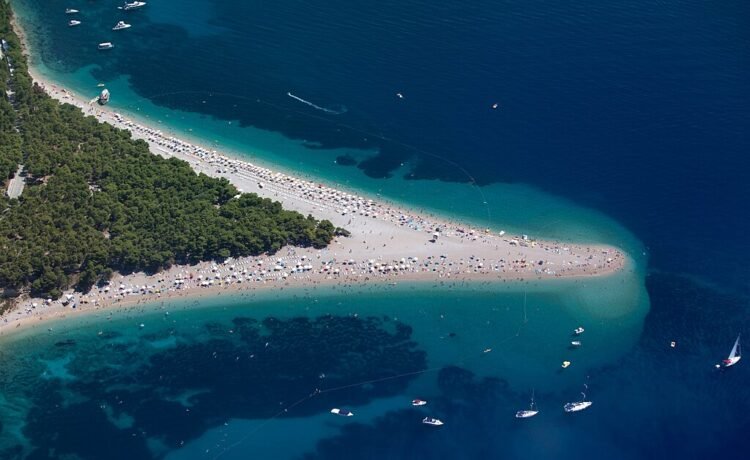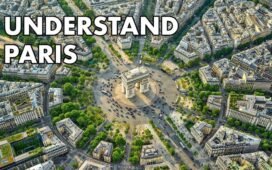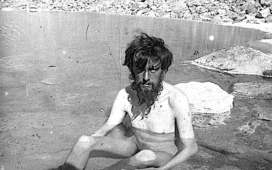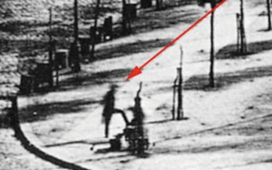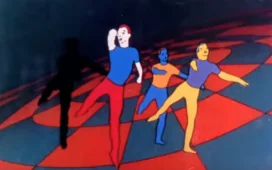My husband and I are sitting on the beach at Šimuni on the island of Pag. The season hasn’t started yet. The shore is almost completely empty. I try not to think about anything, but it’s in vain. A little further from us, a tanned woman with two small preschool children has found her spot. She’s brought her mother along as well. Her husband, I assume, stayed home. When people are stripped down at the seaside, it’s easy to categorize them by class. When you’re half-naked, all that remains are manners, and the way this woman carries herself tells me she would never take out a can of Slovenian Argeta pâté on the beach. She is tanned, but her children are covered in three layers of the strongest suncream and dressed from head to toe. They’re wearing little caps. The sun can’t even get close to them.
I feel a slight irritation, but since I live in Zagreb, I’m used to it. At least, that’s what I think until the youngest child starts wailing inconsolably because his mother has gone somewhere. The grandmother is helpless. It’s clear she’d rather be anywhere else. The child’s mother returns. She kneels and pulls her offspring into a tight embrace. She starts to rock him. Apart from a handful of Slovenian tourists, my husband and I are her only audience, yet she insists on the melodrama. She loudly repeats to the child a hundred times, suffocating him: ‘I will never leave you. Never! Never!’ I turn around to check whether HRT (Hrvatska radiotelevizija, Croatian Radiotelevision) has set up its cameras somewhere nearby, but there’s nothing in sight. The woman rocks the child like a rag doll. Her mise-en-scène is the Dalmatian pebbles and a waitress in the background. Just at the moment when you’d expect a grand red curtain to drop onstage, the ramp of the Lastovo, a ten-ton vessel operated by Croatia’s national ferry company Jadrolinija, crashes down 30 kilometres to the west in Mali Lošinj, crushing three crew members. They all die. End scene.
An invasive species
‘An ugly thing, that is what you are when you become a tourist, writes the Antiguan-American author Jamaica Kincaid in her 1988 essay A Small Place, ‘an ugly, empty thing, a stupid thing, a piece of rubbish pausing here and there to gaze at this and taste that, and it will never occur to you that the people who inhabit the place in which you have just paused cannot stand you’. Kincaid argues that every person is a potential tourist, though some are too poor to ever become one. The author may be writing about the Caribbean, but everything she says applies just as well to the blue Adriatic. Tourism is, after all, a universal evil.
For Croatia’s context, however, we need to revise and expand the notion of a tourist. It’s not enough to stick to the usual distinction between domestic and foreign visitors, as the media have trained us to think. It’s obvious, for example, that the woman I mentioned is a tourist. My husband and I are also tourists on the Adriatic. But it’s just as easy to recognize Jadrolinija’s CEO, David Sopta, who is affiliated with the Croatian Democratic Union (HDZ), as ‘a piece of rubbish pausing here and there’. Aren’t the domestic executives who are destroying the shipbuilding industry, ravaging the coastline and forests, the most despised kind of outsiders? After they ruin one location, their company simply relocates them somewhere else, allowing them to continue their destruction undisturbed. They never take responsibility. They never face consequences. Like tourists, they are an invasive species.
We could easily write an entire novel about the scourge of armed and arrogant Italian tourists who come to Croatia for poaching, but why not also focus on former Croatian MP Josipa Rimac, the textbook example of a privileged tourist who has no regard for the coastline? Throughout her political career, this well-known HDZ politician has shown far more interest in partying and sailing than she has in the well-being of Croatia. Each of these politicians who are merely using Croatia (former president Kolinda Grabar-Kitarović, MP Ante Sanader, former EC vice president/European Commissioner for Mediterranean Dubravka Šuica) are, as Kincaid succinctly put it, ‘an ugly, empty thing, a stupid thing, a piece of rubbish’.
Pillaging paradise
The easiest way to recognize a piece of rubbish is by its inability to imagine the Croatian coast without the union of mass tourism and illegal development. It exploits the coastline for profit and uses Zagreb for money laundering. That’s why, when I see an expensive car with Split plates in Zagreb (a sight that is becoming increasingly common), the person behind the wheel is as exposed as they would be on a nudist beach: it’s clear that they’re an impostor who, in Dalmatia as well as in Zagreb, is just another outsider. Catamarans and ferries drift around the Adriatic islands like old scrap metal, while executives buy and drive brand-new luxury cars. While public infrastructure crumbles, their families spend three-month-long summers in top-tier, private hotels and villas. And as the wealthy cruise around Zagreb trading in property, down south every drystone wall is slowly turning into reinforced concrete, and the deafening noise of construction is hammering its way into all of our heads. The local lowlife, sell out their inherited land for euros to foreigners so they can afford a better car and drive off, perhaps even to Brussels to become foreigners. The price per square metre in Split didn’t climb to €8,500 on its own. Everybody knows it! In order to drive up the price of a square metre, the lowlife let that ramp fall.
The accident that killed three sailors was not the end of Jadrolinija’s problems (though thankfully, subsequent incidents unfolded without further loss of life). Each one brought me back to the remarks made by David Sopta, who of course remained at the helm of Jadrolinija. Instead of stepping down, he said he was sorry that the death of the sailors had ‘simply slightly overshadowed’ the company’s good results ─ namely, the acquisition of five new catamarans ─ and insisted that the focus should be on the tourist season ‘because that is the company’s main mission’. The language used by this HDZ executive is entirely dehumanizing. Three human lives become a secondary issue compared to five new vessels. Within the company’s hierarchy, ‘results, mission and the season’ take precedence over the workers. Profit is more valuable than human life ─ this is the message of the party cadres.
By now, ‘season’ has become a byword for robbery, but not the kind everyone thinks of when they hear about the Adriatic coast. Forget the viral photos of outrageously high restaurant bills for coffee and meals that Croatian media sell as news every summer. Tourism is the organized looting of the Croatian coastline. That’s the robbery I’m talking about. But journalists wanting to write about the organized criminal enterprise known as ‘the season’ wouldn’t need to sip espresso on Dubrovnik’s elegant main street Stradun – they would need to go after the real culprits in Zagreb. Yet, since only the poor stay home in the summer to sadly contemplate life, everyone else can’t wait to become cheerful tourists, including left-leaning intellectuals and journalists. Every summer, Zagreb abandons its political and cultural engagement to lounge on the beach, and it’s hard to write critically about tourism from a sun lounger. That’s why we need to seize the winter, when we are all equally depressed, to deal with mass tourism, from which no one has ever truly had a break.
As soon as we stop taking the concept of tourism for granted as something inherently positive, it suddenly becomes clear that Dalmatia is not a paradise ruined by rude waiters and poor restaurant offerings, but rather a hell administered by local politicians and investors who reduce people to eking out a livelihood in lowly hospitality roles as waiters, sailors and cooks. Personally, I would be the most unpleasant waitress in all of Dalmatia if waiting tables were my only option for earning a living! After all, just because someone was born in the south doesn’t mean they were made for the service industry. Just look at the islanders! Sometimes I think they are the only people in Croatia who are even greater misanthropes than I am. People from the mainland easily forget the cuttlefish ink in the Dalmatian soul because the real, melancholic image of the south does not fit the banal postcards that Zagreb’s tabloid media shove in our faces every year. In the press, Dalmatians are never portrayed as oppressed – they are always depicted as buffoons and greedy primitives, cannon fodder for HDZ. And worst of all, Dalmatia itself begins to live this lie. It readily accepts it. And then that ugly image of the coast reflects onto Zagreb, which also becomes repulsive.
Dismantling Croatia, stone by stone
Every news story I open paints the south of Croatia as a madhouse. ‘Man arrested after trying to poison child with rodent poison near Trogir’, reads a recent news headline from Dalmatia about a town halfway up Croatia’s coast. The art historian and conservator Cvito Fisković wrote this about Trogir over 60 years ago: ‘Malaria and poverty have disappeared, class differences between the nobility and the common folk have faded away, the bells are growing quieter, the old dialect is dying out, but in summer, the shallows are filled with the noisy games of youth, and in winter, under the beams of old ground floors, the smell of grilled fish mingles with the ever-warmer conversations of the young, their ventures ever bolder, their loves ever more sensual’. Much has changed since then. Malaria may be gone, but poverty is making a comeback. So are class differences. Dalmatians no longer have time to enjoy the shallows in summer because they are enslaved by the tourism machine in order to fill Croatia’s budget. Winter in Trogir? There is no winter in Trogir because, like the rest of Dalmatia, Trogir ceases to exist in winter. Unless, of course, someone is trying to kill a child with rat poison.
The plundering of the Adriatic coast has been going on for decades, and it didn’t begin with the Croatian Democratic Union, though it seems that this party is now the primary executor of all suspicious construction projects. In his 1955 text For the Urban Integrity of Korčula, in which he advocates for the restoration of old houses in the town of Korčula, Fisković warns that ‘one should not stumble over the small profits that individuals “enjoy” in this neglect’. But at that time, he could still appeal to the Split Urban Planning Office and the Dalmatian Conservation Institute to protect the public interest. Unfortunately, if we fast-forward 70 years, we end up with white PVC windows installed on Klis Fortress – windows that would have remained part of this heritage site from the fifth century had individuals not protested and pressured the HDZ mayor, Jakov Vetma, to have them removed. If the contractors had even the slightest concern for Klis, it would never have occurred to them to use plastic frames, but these small tourist-driven profits are dismantling Croatia, stone by stone. Urban planning that once kept these interests in check no longer exists. Now, we have HDZ and the Ministry of Tourism to take care of ‘restoration’.
Tourism’s environment
My husband and I have been spending our summers in Pag for the past few years, staying with Uncle Toni and Aunt Ruža. We rent a small room with a bathroom, and without a kitchen, at a very low price. We always vacation off-season to save money and avoid the heat – and most importantly, for the birds. Pag has wonderful ornithological reserves – Veliko, Malo and Kolansko Blato – where you can observe species that don’t exist on the mainland. But the last time we went to one of our usual birdwatching spots near Kolan, we were met with a construction site: someone had started building an exclusive weekend resort right on the shore. And as you continue toward Lun, with its stunning ancient olive trees, you pass through Novalja, which is now completely deformed by new construction. I don’t even know how to describe the impact of this cultural destruction on Pag’s minimalist landscape. There is something eerie about scanning for glossy ibises and whimbrels through binoculars, only to find concrete and sunburned tourist backsides.
A headline I read on morski.hr says it all: ‘City of Novalja plants olive trees for 45 euros, pays 1,186 euros per piece? HDZ mayor explains…’. But do we really need any more explanations? Now that the seasonal sun is no longer frying our brains, things are clearer than ever. A few olive trees can’t hide HDZ’s ‘good results’. Not in Novalja, nor anywhere else.
Of course, the issue of devastation isn’t limited to Dalmatia. More than 40 years ago, writer Srebrenka Iveković-Marinović and art historian Berislav Valušek warned of the systematic destruction of the town of Opatija, just west of Rijeka. In their newspaper article ‘The Tourist Queen and the Cultural Dwarfs’ (Danas, 18 May 1982), they outlined a series of problems that plague the Croatian coast to this day. The authors explained to Yugoslav readers that architecture and greenery were the defining features of Opatija, setting it apart from other destinations, and that these very elements had become ‘the target of shooters with short-range thinking’. They argued that environmental destruction could only be profitable in the short term. In the long run, all this rampant demolition and redevelopment would lead to the disappearance of Opatija’s originality, which, of course, is exactly what happened. In their article, they harshly criticized the Hotel Admiral, which at the time had three TV lounges instead of paintings: ‘That hotel is, even in terms of architecture, a good example of the level of awareness of those in power’. In their view, the Admiral did not fit into its surroundings and symbolized a wave of inappropriate new constructions and expansions that were ‘slowly but surely destroying the historic unity of Opatija’s villas, palaces and hotels’.
It’s worth noting that those who fought against coastal devastation and illegal construction back in Yugoslavia were mostly art historians and conservators, people who actually knew what they were talking about. On the other side, we have the so-called ‘cultural dwarfs’ – those who cater to investors and remove cultural landmarks to make coastal towns look as sterile and impersonal as possible. For these pieces of rubbish, crime serves as a way to ‘culturally’ distance themselves from the poor. It’s clear that in Croatia, tourism deepens class divisions and promotes the segregation of citizens who can’t afford vacations or home renovations. At the same time, as their environment is increasingly transformed into an ugly and exclusive tourist destination, the options for local residents shrink. They can choose to remain poor, or to become part of the machine. I think this choice between two evils perfectly explains HDZ’s popularity in Dalmatia.
Betraying the Adriatic
The south of Croatia, however, has not only been devastated in terms of construction. It has also been culturally destroyed. It may be full of music festivals and events, but the local population cannot attend because they are organized exclusively for foreigners. Dubrovnik has become an exclusive destination for Americans and wealthy tourists. If access to public beaches isn’t literally blocked by illegal concrete barriers and concessions, then Croatian citizens are often priced out of the coast. After all, not all obstacles are physical; many of them fall within the cultural sphere – gastronomy, for example. In the summer, it’s incredibly difficult to buy fresh seafood in Zagreb. At first, I thought all the fish stayed in Dalmatia, but after speaking with Dalmatians, I realized that even they don’t have easy access to it. The summer school organized by Praxis on Korčula, the public assemblies on Hvar and Dubrovnik seminars on socialism and class issues, where figures like Miko Tripalo and other Croatian philosophers and communists once spoke are things of the past. Cultural activity in Dalmatia has been reduced to amateur souvenir-making. Instead of critically reading the seventeenth-century Croatian writer Junije Palmotić’s polemical poem Gomnaida in the summer (which has never been more relevant), we’re dealing with literal shit spilling onto our beaches!
The ‘cultural dwarfs’ mentioned by Valušek and Iveković-Marinović have not only spent decades building grotesque new developments, but in doing so they have also demolished a culture in which people had grown up and lived continuously for centuries. The discourse on the Croatian coastline, the Adriatic and the Mediterranean in general has been reduced to semi-literate newspaper articles about child poisonings and the entrepreneur-turned-politician Željko Kerum. Once a real place to live, the coast has become, in winter, a graveyard of empty properties. New tourist-driven construction has displaced the local population. Along with the influx of luxury cars, the south manifests itself in Zagreb in the form of cashiers, hairdressers and those working in culture. Many from the south flee to Zagreb to survive because tourism consumes everything in its path, including normal life. Istrians and Dalmatians are forced to live in the capital, and this forced relocation turns Zagreb into a place they despise. In my view, the long-term solution to this problem lies in high property taxes and, even more importantly, the decentralization of Croatia. Unfortunately, we know that high property taxes won’t be introduced until foreigners become locals, that is, until they have bought up everything that can be bought and renovated. Once their voters have sold off all their family homes to tourists, then and only then will HDZ finally impose taxes.
Like property taxes, decentralization has become a necessity, and not only for the survival of Dalmatia, the Kvarner Gulf and Istria. The advantages would go both ways, because just as Dalmatia is dead in the winter, Zagreb is a terrible place to live in the summer. If the Croatian coastline were allowed some autonomy from the capital, Zagreb would finally lose its role as the perpetual villain. First and foremost, the capital must stop claiming ownership over the coast and treating it as if the Velebit mountain range were just a slightly larger version of Zagreb’s own mountain Medvednica. This separation would encourage Zagreb to develop better seasonal activities and open the public pools that undergo maintenance every summer and remain closed to the public during the worst heat waves. Secondly, Croatia looks different when viewed from the south, and that different perspective should be nurtured and respected. ‘Regions are people, and people are regions’, says the Croatian poet and traveller Antun Gustav Matoš in a 1969 guide to excursion destinations from Zagreb. That guide does not include the Adriatic coast. Only those places that are geographically and culturally close to Zagreb are listed. Instead of Kvarner and Istria, it lists Slovenia and Slavonia.
But the most important reason to collectively fight against the tourist-driven obsession with the Adriatic is climate change. Global warming is the main point of convergence between tourism and illegal development, but mainstream media rarely write about it. Last year, there was a massive mussel die-off in Mali Ston Bay. I don’t think that horrifying news even made waves. Partly because sea temperatures are only considered relevant when discussing tourist comfort, and partly because tourists typically don’t like mussels, but instead prefer the meat dishes they are used to. Southern Europe is getting hotter. Fires are becoming more frequent and last longer. Those who care have been warning about the lack of drinking water during peak season, especially in places whose infrastructure simply cannot support the vast number of overnight stays that fuel the state budget. The Adriatic coast is an invaluable treasure, but it is not limitless. It consists of natural resources and people, both of which Croatian society is relentlessly consuming through mass tourism. Does that mean we should completely abandon the sea in the future? Of course not!
Our relationship with the Adriatic doesn’t have to be purely touristic for us to enjoy it. ‘I am lying on the warm sandy shoal of the Northern Adriatic, watching the play of cotton-like clouds over Vrbnik’, writes Gustav Krklec. As he puts it, he lies and daydreams on the island of Krk, ‘on a shimmering, sparkling July sand carpet’, longing for solitude, which is disrupted by the surrounding clamour – the tourist bustle that ‘bypasses all social conventions and established customs’. However, Krklec, in his 1958 article for Zagreb’s Vjesnik, also quotes the wanderer Matoš: ‘Travelling, that is the poetry of modern civilization’, the writer does not look kindly on the foreign tourists just beginning to discover Yugoslavia. An incidental encounter with a Westerner who ignorantly places Yugoslavia behind the Iron Curtain makes it clear that Krklec does not see himself as a tourist. He is lying on the sandbank, but that sandbank is also part of Yugoslavia. He did not come to the Adriatic to escape politics, because the Adriatic coast is not some imaginary, escapist destination, and lounging on the beach, for that matter, is far from apolitical. So what has happened in the meantime that so radically changed our perception of the south, and how did we betray the blue Adriatic so badly? Mass tourism and illegal development have taken a dump on all of us. That’s what has happened. We got the scumbags, the bastards and their corporations.
Breaking free
Let’s return to the beginning of my text, to the irritation I felt watching someone’s pretentious behaviour ruin my view. Tourist behaviour is highly theatrical because, as Krklec observed, it ‘bypasses all social conventions and established customs’. In that melodramatic, philistine swaying of a child, in the selfish, performative love of a mother, I recognized a pattern I frequently encounter in Croatia – not just in family dynamics but in everyday politics. Croatian politics has been stripped of real relationships and reduced to imaginary patriotism that rocks the Croatian public, as if to soothe and protect it from a hostile world. But the real, internal enemy, as the old Yugoslav communists would say, is precisely that grip, that swaying motion which lulls us into a false sense of security. I think it is clear from my text which party’s grip is choking us, in whose vice our heads are slowly being crushed. To break free from it, we must first liberate Dalmatia, and then Dalmatia will liberate Zagreb. After that, the rest will be easy.
This article was first published by Kultur Punkt. Its translation from Croatian into English was commissioned as part of Come Together, a project leveraging existing wisdom from community media organization in six different countries to foster innovative approaches.


